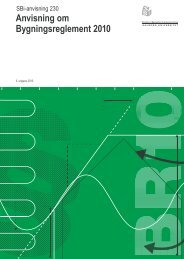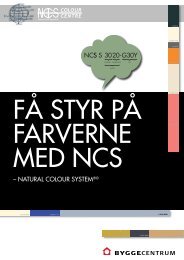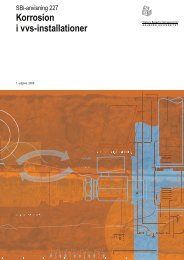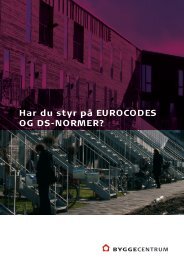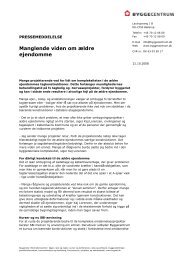EN 1993-3-1 - Byggecentrum
EN 1993-3-1 - Byggecentrum
EN 1993-3-1 - Byggecentrum
- No tags were found...
Create successful ePaper yourself
Turn your PDF publications into a flip-book with our unique Google optimized e-Paper software.
Single user license. Byggedata udgave<strong>EN</strong> <strong>1993</strong>-3-1:2006 (E)A.2 Partial factors for actions..................................................................................................................26Annex B [informative] – Modelling of meteorological actions ...................................................................27B.1 General .............................................................................................................................................27B.2 Wind force........................................................................................................................................28B.3 Response of lattice towers................................................................................................................40B.4 Response of guyed masts .................................................................................................................45Copyright © Danish Standards. NOT FOR COMMERCIAL USE OR REPRODUCTIONAnnex C [informative] – Ice loading and combinations of ice with wind..................................................53C.1 General .............................................................................................................................................53C.2 Ice loading........................................................................................................................................53C.3 Ice weight.........................................................................................................................................54C.4 Wind and ice ....................................................................................................................................54C.5 Asymmetric ice load ........................................................................................................................54C.6 Combinations of ice and wind..........................................................................................................55Annex D [normative] – Guys, dampers, insulators, ancillaries and other items ......................................56D.1 Guys .................................................................................................................................................56D.2 Dampers ...........................................................................................................................................56D.3 Insulators..........................................................................................................................................57D.4 Ancillaries and other items...............................................................................................................57Annex E [informative] – Guy rupture ..........................................................................................................59E.1 Introduction......................................................................................................................................59E.2 Simplified analytical model .............................................................................................................59E.3 Conservative procedure....................................................................................................................60E.4 Analysis after a guy rupture .............................................................................................................61Annex F [informative] – Execution...............................................................................................................62F.1 General .............................................................................................................................................62F.2 Bolted connections...........................................................................................................................62F.3 Welded connections .........................................................................................................................62F.4 Tolerances ........................................................................................................................................62F.5 Prestretching of guys........................................................................................................................63Annex G [informative] – Buckling of components of masts and towers....................................................64G.1 Buckling resistance of compression members .................................................................................64G.2 Effective slenderness factor k ..........................................................................................................64Annex H [informative] – Buckling length and slenderness of members ...................................................70H.1 General .............................................................................................................................................70H.2 Leg members....................................................................................................................................70H.3 Bracing members .............................................................................................................................71H.4 Secondary bracing members ............................................................................................................78H.5 Shell structures.................................................................................................................................793
Single user license. Byggedata udgave<strong>EN</strong> <strong>1993</strong>-3-1:2006 (E)ForewordThis European Standard <strong>EN</strong> <strong>1993</strong>-3-1, Eurocode 3: Design of steel structures: Part 3.1: Towers, masts andchimneys – Towers and masts, has been prepared by Technical Committee C<strong>EN</strong>/TC250 « StructuralEurocodes », the Secretariat of which is held by BSI. C<strong>EN</strong>/TC250 is responsible for all Structural Eurocodes.This European Standard shall be given the status of a National Standard, either by publication of an identicaltext or by endorsement, at the latest by April 2007 and conflicting National Standards shall be withdrawnat latest by March 2010.Copyright © Danish Standards. NOT FOR COMMERCIAL USE OR REPRODUCTIONThis Eurocode supersedes <strong>EN</strong>V <strong>1993</strong>-3-1.According to the C<strong>EN</strong>-C<strong>EN</strong>ELEC Internal Regulations, the National Standard Organizations of thefollowing countries are bound to implement this European Standard: Austria, Belgium, Cyprus, CzechRepublic, Denmark, Estonia, Finland, France, Germany, Greece, Hungary, Iceland, Ireland, Italy, Latvia,Lithuania, Luxembourg, Malta, Netherlands, Norway, Poland, Portugal, Romania, Slovakia, Slovenia, Spain,Sweden, Switzerland and United Kingdom.Background of the Eurocode programmeIn 1975, the Commission of the European Community decided on an action programme in the field ofconstruction, based on article 95 of the Treaty. The objective of the programme was the elimination oftechnical obstacles to trade and the harmonisation of technical specifications.Within this action programme, the Commission took the initiative to establish a set of harmonised technicalrules for the design of construction works which, in a first stage, would serve as an alternative to the nationalrules in force in the Member States and, ultimately, would replace them.For fifteen years, the Commission, with the help of a Steering Committee with Representatives of MemberStates, conducted the development of the Eurocodes programme, which led to the first generation ofEuropean codes in the 1980s.In 1989, the Commission and the Member States of the EU and EFTA decided, on the basis of an agreement 1between the Commission and C<strong>EN</strong>, to transfer the preparation and the publication of the Eurocodes to theC<strong>EN</strong> through a series of Mandates, in order to provide them with a future status of European Standard (<strong>EN</strong>).This links de facto the Eurocodes with the provisions of all the Council’s Directives and/or Commission’sDecisions dealing with European standards (e.g. the Council Directive 89/106/EEC on construction products– CPD – and Council Directives 93/37/EEC, 92/50/EEC and 89/440/EEC on public works and services andequivalent EFTA Directives initiated in pursuit of setting up the internal market).The Structural Eurocode programme comprises the following standards generally consisting of a number ofParts:<strong>EN</strong> 1990 Eurocode 0: Basis of structural design<strong>EN</strong> 1991 Eurocode 1: Actions on structures<strong>EN</strong> 1992 Eurocode 2: Design of concrete structures<strong>EN</strong> <strong>1993</strong> Eurocode 3: Design of steel structures<strong>EN</strong> 1994 Eurocode 4: Design of composite steel and concrete structures<strong>EN</strong> 1995 Eurocode 5: Design of timber structures<strong>EN</strong> 1996 Eurocode 6: Design of masonry structures<strong>EN</strong> 1997 Eurocode 7: Geotechnical design1Agreement between the Commission of the European Communities and the European Committee for Standardisation(C<strong>EN</strong>) concerning the work on EUROCODES for the design of building and civil engineering works(BC/C<strong>EN</strong>/03/89).4
Single user license. Byggedata udgave<strong>EN</strong> <strong>1993</strong>-3-1:2006 (E)<strong>EN</strong> 1998 Eurocode 8: Design of structures for earthquake resistance<strong>EN</strong> 1999 Eurocode 9: Design of aluminium structuresEurocode standards recognise the responsibility of regulatory authorities in each Member State and havesafeguarded their right to determine values related to regulatory safety matters at national level where thesecontinue to vary from State to State.Status and field of application of EurocodesCopyright © Danish Standards. NOT FOR COMMERCIAL USE OR REPRODUCTIONThe Member States of the EU and EFTA recognise that Eurocodes serve as reference documents for thefollowing purposes :– as a means to prove compliance of building and civil engineering works with the essential requirementsof Council Directive 89/106/EEC, particularly Essential Requirement N°1 - Mechanical resistance andstability - and Essential Requirement N°2 - Safety in case of fire;– as a basis for specifying contracts for construction works and related engineering services;– as a framework for drawing up harmonised technical specifications for construction products (<strong>EN</strong>s andETAs)The Eurocodes, as far as they concern the construction works themselves, have a direct relationship with theInterpretative Documents 2 referred to in Article 12 of the CPD, although they are of a different nature fromharmonised product standard 3 . Therefore, technical aspects arising from the Eurocodes work need to beadequately considered by C<strong>EN</strong> Technical Committees and/or EOTA Working Groups working on productstandards with a view to achieving a full compatibility of these technical specifications with the Eurocodes.The Eurocode standards provide common structural design rules for everyday use for the design of wholestructures and component products of both a traditional and an innovative nature. Unusual forms ofconstruction or design conditions are not specifically covered and additional expert consideration will berequired by the designer in such cases.National Standards implementing EurocodesThe National Standards implementing Eurocodes will comprise the full text of the Eurocode (including anyannexes), as published by C<strong>EN</strong>, which may be preceded by a National title page and National foreword, andmay be followed by a National annex (informative).The National Annex (informative) may only contain information on those parameters which are left open inthe Eurocode for national choice, known as Nationally Determined Parameters, to be used for the design ofbuildings and civil engineering works to be constructed in the country concerned, i.e. :– values for partial factors and/or classes where alternatives are given in the Eurocode,– values to be used where a symbol only is given in the Eurocode,– geographical and climatic data specific to the Member State, e.g. snow map,– the procedure to be used where alternative procedures are given in the Eurocode,– references to non-contradictory complementary information to assist the user to apply the Eurocode.23According to Art. 3.3 of the CPD, the essential requirements (ERs) should be given concrete form in interpretativedocuments for the creation of the necessary links between the essential requirements and the mandates for h<strong>EN</strong>s andETAGs/ETAs.According to Art. 12 of the CPD the interpretative documents should :a) give concrete form to the essential requirements by harmonising the terminology and the technical bases andindicating classes or levels for each requirement where necessary ;b) indicate methods of correlating these classes or levels of requirement with the technical specifications, e.g.methods of calculation and of proof, technical rules for project design, etc. ;c) serve as a reference for the establishment of harmonised standards and guidelines for European technicalapprovals.The Eurocodes, de facto, play a similar role in the field of the ER 1 and a part of ER 2.5
Single user license. Byggedata udgave<strong>EN</strong> <strong>1993</strong>-3-1:2006 (E)Links between Eurocodes and product harmonized technical specifications (<strong>EN</strong>sand ETAs)There is a need for consistency between the harmonised technical specifications for construction productsand the technical rules for works 4 . Furthermore, all the information accompanying the CE Marking of theconstruction products which refer to Eurocodes should clearly mention which Nationally DeterminedParameters have been taken into account.Additional information specific to <strong>EN</strong> <strong>1993</strong>-3-1 and <strong>EN</strong> <strong>1993</strong>-3-2Copyright © Danish Standards. NOT FOR COMMERCIAL USE OR REPRODUCTION<strong>EN</strong> <strong>1993</strong>-3 is the third part of six parts of <strong>EN</strong> <strong>1993</strong> - Design of Steel Structures - and describes the principlesand application rules for the safety and serviceability and durability of steel structures for towers and mastsand chimneys. Towers and masts are dealt with in Part 3-1; chimneys are treated in Part 3-2.<strong>EN</strong> <strong>1993</strong>-3 gives design rules in supplement to the generic rules in <strong>EN</strong> <strong>1993</strong>-1.<strong>EN</strong> <strong>1993</strong>-3 is intended to be used with Eurocodes <strong>EN</strong> 1990 - Basis of design, <strong>EN</strong> 1991 - Actions onstructures and the parts 1 of <strong>EN</strong> 1992 to <strong>EN</strong> 1998 when steel structures or steel components for towers andmasts and chimneys are referred to.Matters that are already covered in those documents are not repeated.<strong>EN</strong> <strong>1993</strong>-3 is intended for use by– committees drafting design related product, testing and execution standards;– clients (e.g. for the formulation of their specific requirements);– designers and constructors;– relevant authorities.Numerical values for partial factors and other reliability parameters in <strong>EN</strong> <strong>1993</strong>-3 are recommended as basicvalues that provide an acceptable level of reliability. They have been selected assuming that an appropriatelevel of workmanship and quality management applies.Annex B of <strong>EN</strong> <strong>1993</strong>-3-1 has been prepared to supplement the provisions of <strong>EN</strong> 1991-1-4 in respect of windactions on lattice towers and guyed masts or guyed chimneys.As far as overhead line towers are concerned all matters related to wind and ice loading, loadingcombinations, safety matters and special requirements (such as for conductors, insulators, clearance, etc.) arecovered by the C<strong>EN</strong>ELEC Code <strong>EN</strong> 50341, that can be referred to for the design of such structures.The strength requirements for steel members given in this Part may be considered as 'deemed to satisfy',rules to meet the requirements of <strong>EN</strong> 50341 for overhead line towers, and may be used as alternative criteriato the rules given in that Standard.Part 3.2 has been prepared in collaboration with Technical Committee C<strong>EN</strong>/TC 297: Free standingchimneys.Provisions have been included to allow for the possible use of a different partial factor for resistance in thecase of those structures or elements the design of which has been the subject of an agreed type testingprogramme.4See Art.3.3 and Art.12 of the CPD, as well as clauses 4.2, 4.3.1, 4.3.2 and 5.2 of ID 1.6
Single user license. Byggedata udgave<strong>EN</strong> <strong>1993</strong>-3-1:2006 (E)National Annex for <strong>EN</strong> <strong>1993</strong>-3-1This standard gives alternative procedures, values and recommendations for classes with notes indicatingwhere national choices may have to be made. Therefore the National Standard implementing <strong>EN</strong> <strong>1993</strong>-3-1should have a National Annex containing all Nationally Determined Parameters to be used for the design ofbuildings and civil engineering works to be constructed in the relevant country.Copyright © Danish Standards. NOT FOR COMMERCIAL USE OR REPRODUCTIONNational choice is allowed in <strong>EN</strong> <strong>1993</strong>-3-1 through paragraphs:– 2.1.1(3)P– 2.3.1(1)– 2.3.2(1)– 2.3.6(2)– 2.3.7(1)– 2.3.7(4)– 2.5(1)– 2.6(1)– 4.1(1)– 4.2(1)– 5.1(6)– 5.2.4(1)– 6.1(1)– 6.3.1(1)– 6.4.1(1)– 6.4.2(2)– 6.5.1(1)– 7.1(1)– 9.5(1)– A.1(1)– A.2(1)P (2 places)– B.1.1(1)– B.2.1.1(5)– B.2.3(1)– B.2.3(3)– B.3.2.2.6(4)– B.3.3(1)– B.3.3(2)– B.4.3.2.2(2)– B.4.3.2.3(1)– B.4.3.2.8.1(4)– C.2(1)– C.6.(1)– D.1.1(1)– D.1.2(2)– D.3(6) (2 places)7
Single user license. Byggedata udgave<strong>EN</strong> <strong>1993</strong>-3-1:2006 (E)Copyright © Danish Standards. NOT FOR COMMERCIAL USE OR REPRODUCTION– D.4.1(1)– D.4.2(3)– D.4.3(1)– D.4.4(1)– F.4.2.1(1)– F.4.2.2(2)– G.1(3)– H.2(5)– H.2(7)8
Single user license. Byggedata udgave<strong>EN</strong> <strong>1993</strong>-3-1:2006 (E)1 General1.1 Scope1.1.1 Scope of Eurocode 3See 1.1.1 of <strong>EN</strong> <strong>1993</strong>-1-1.1.1.2 Scope of Part 3.1 of Eurocode 3Copyright © Danish Standards. NOT FOR COMMERCIAL USE OR REPRODUCTION(1) This Part 3.1 of <strong>EN</strong> <strong>1993</strong> applies to the structural design of lattice towers and guyed masts and to thestructural design of this type of structures supporting prismatic, cylindrical or other bluff elements.Provisions for self-supporting and guyed cylindrical towers and chimneys are given in Part 3.2 of <strong>EN</strong> <strong>1993</strong>.Provisions for the guys of guyed structures, including guyed chimneys, are given in <strong>EN</strong> <strong>1993</strong>-1-11 andsupplemented in this Part.(2) The provisions in this Part of <strong>EN</strong> <strong>1993</strong> supplement those given in Part 1.(3) Where the applicability of a provision is limited, for practical reasons or due to simplifications, itsuse is explained and the limits of applicability are stated.(4) This Part does not cover the design of polygonal and circular lighting columns, which is covered in<strong>EN</strong> 40. Lattice polygonal towers are not covered in this Part. Polygonal plated columns (monopoles) maybe designed using this Part for their loading. Information on the strength of such columns may be obtainedfrom <strong>EN</strong> 40.(5) This Part does not cover special provisions for seismic design, which are given in <strong>EN</strong> 1998-3.(6) Special measures that might be necessary to limit the consequences of accidents are not covered inthis Part. For resistance to fire, reference should be made to <strong>EN</strong> <strong>1993</strong>-1-2.(7) For the execution of steel towers and masts, reference should be made to <strong>EN</strong> 1090.NOTE: Execution is covered to the extent that is necessary to indicate the quality of the constructionmaterials and products that should be used and the standard of workmanship on site needed to comply with theassumptions of the design rules.1.2 Normative referencesThe following normative documents contain provisions which, through reference in this text, constituteprovisions of this European Standard. For dated references, subsequent amendments to, or revisions of, anyof these publications do not apply. However, parties to agreements based on this European Standard areencouraged to investigate the possibility of applying the most recent editions of the normative documentsindicated below. For undated references, the latest edition of the normative document referred to applies.<strong>EN</strong> 40 Lighting columns<strong>EN</strong> 365 Personal protective equipment against falls from a height. General requirements forinstructions for use, maintenance, periodic examination, repair, marking and packaging<strong>EN</strong> 795 Protection against falls from a height. Anchor devices. Requirements and testing<strong>EN</strong> 1090 Execution of steel structures and aluminium structures<strong>EN</strong> ISO 1461 Hot dip galvanized coatings on fabricated iron and steel articles. Specifications and testmethods<strong>EN</strong> ISO 14713 Protection against corrosion of iron and steel in structures. Zinc and aluminium coatings.GuidelinesISO 12494 Atmospheric icing of structures<strong>EN</strong> ISO 12944 Corrosion protection of steel structures by protective paint systems.9
Single user license. Byggedata udgave<strong>EN</strong> <strong>1993</strong>-3-1:2006 (E)1.3 Assumptions(1) See 1.3 of <strong>EN</strong> <strong>1993</strong>-1-1.1.4 Distinction between principles and application rules(1) See 1.4 of <strong>EN</strong> <strong>1993</strong>-1-1.1.5 Terms and definitionsCopyright © Danish Standards. NOT FOR COMMERCIAL USE OR REPRODUCTION(1) The terms and definitions that are defined in <strong>EN</strong> 1990 clause 1.5 for common use in the StructuralEurocodes apply to this Part 3.1 of <strong>EN</strong> <strong>1993</strong>.(2) Supplementary to Part 1 of <strong>EN</strong> <strong>1993</strong>, for the purposes of this Part 3.1, the following definition apply:1.5.1global analysisthe determination of a consistent set of internal forces and moments in a structure, that are in equilibriumwith a particular set of actions on the structure.1.5.2towera self-supporting cantilevered steel lattice structure of triangular, square or rectangular plan form, or circularand polygonal monopoles.1.5.3guyed masta steel lattice structure of triangular, square or rectangular plan form, or a cylindrical steel structure,stabilized at discrete intervals in its height by guys that are anchored to the ground or to a permanentstructure.1.5.4shaftthe vertical steel structure of a mast.1.5.5leg memberssteel members forming the main load-bearing components of the structure.1.5.6primary bracing membersmembers other than legs, carrying forces due to the loads imposed on the structure.1.5.7secondary bracing membersmembers used to reduce the buckling lengths of other members.1.5.8schifflerized anglesmodified 90° equal-leg hot rolled angles, each leg of which has been bent to incorporate a 15° bend such thatthere is an angle of 30° between the outer part of each leg and the axis of symmetry (see Figure 1.1).1.5.9wind dragthe resistance to the flow of wind offered by the elements of a tower or guyed mast and any ancillary itemsthat it supports, given by the product of the drag coefficient and a reference projected area, including icewhere relevant.10
Single user license. Byggedata udgave<strong>EN</strong> <strong>1993</strong>-3-1:2006 (E)1.5.10linear ancillary itemany non-structural components that extend over several panels, such as waveguides, feeders, ladders andpipework.1.5.11discrete ancillary itemany non-structural component that is concentrated within a few panels, such as dish reflectors, aerials,lighting, platforms, handrails, insulators and other items.Copyright © Danish Standards. NOT FOR COMMERCIAL USE OR REPRODUCTION1.5.12projected areathe shadow area of the element considered, when projected on to an area parallel to the face of the structurenormal to the wind direction considered, including ice where relevant. For wind blowing other than normalto one face of the structure, a reference face is used for the projected area. (See Annex A and Annex B.)1.5.13panel (of a tower or mast)any convenient portion of a tower or mast that is subdivided vertically for the purpose of determiningprojected areas and wind drag. Panels are typically, but not necessarily, taken between intersections of legsand primary bracings.1.5.14section (of a tower or mast)any convenient portion of a tower or mast comprising several panels that are nearly or exactly similar, usedfor the purpose of determining wind drag.1.5.15guya tension-only member, connected at each end to terminations to form a guy assembly that provideshorizontal support to the mast at discrete levels. The lower end of the guy assembly is anchored to theground or on a structure and generally incorporates a means of adjusting the tension in the guy.NOTE 1: Although the terms “stay” and “guy” are generally interchangeable, the word “guy” has been usedthroughout this document.NOTE 2: Specific definitions of guys, their make-up and fittings, are provided in Annex D.1.5.16dampera device that increases the structural damping and thus limits the response of a structure or of a guy.1.6 Symbols(1) In addition to those given in <strong>EN</strong> <strong>1993</strong>-1-1, the following main symbols are used:Latin upper case lettersD b diameter of the circle through the centre of the bolt holeD i diameter of the leg memberG gust response factorM bending momentN tension force, number of cyclesN i number of cyclesN b axial forceT design life of the structure in years11
Single user license. Byggedata udgave<strong>EN</strong> <strong>1993</strong>-3-1:2006 (E)Copyright © Danish Standards. NOT FOR COMMERCIAL USE OR REPRODUCTIONLatin lower case lettersb width of a leg of an anglee)(zc exposure factordscstructural factore eccentricitiesh width of a leg of an anglek p prying effect factork σ buckling coefficientm slope of the S-N curven number of boltsr 1 radius of the convex part of the bearingr 2 radius of the concave part of the bearingt thicknessGreek upper case lettersφ is the inclination of the mast axis at its base∆σ E stress rangeGreek lower case lettersβ A factor for effective areaγ M partial factorδ s logarithmic decrement of structural dampingε coefficient depending on f yλ non-dimensional slenderness parameter, equivalence factornon-dimensional slenderness for plate bucklingλ pλ p 1, non-dimensional slenderness parameter for plate buckling of leg 1 of angleλ p 2, non-dimensional slenderness parameter for plate buckling of leg 2 of angleρ reduction factor(2) Further symbols are defined where they first occur.1.7 Convention for cross section axes(1) The convention for axes of angle sections adopted in this Part of <strong>EN</strong> <strong>1993</strong> is as shown in Figure 1.1.NOTE: This avoids the confusion inherent in adopting different conventions for hot rolled angles and coldformed angles.(2) For built-up members the convention for axes is that of Figure 6.9 of <strong>EN</strong> <strong>1993</strong>-1-1.12



